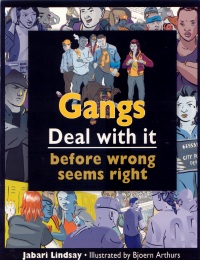| ________________
CM . . .
. Volume XIX Number 12. . . .November 23, 2012.
excerpt:
Part of the “Deal With It” series, designed to help young adolescents cope with conflicts and situations in their daily lives and to “promote peaceful homes, schools and communities”, Gangs provides kids with an understanding of the reasons why kids join gangs and offers food for thought to those who are contemplating joining a gang and helpful suggestions for those trying to leave one. All of the series’ books are identical in layout and will appeal to their intended audience, but in a limited setting- i.e. the books are more likely to be used by guidance counsellors working with individuals or specific groups of students rather than by the students, themselves, checking the books out of the library. The books’ contents consist of comic strips, quizzes, letters to a “Conflict Counsellor”, a double-page spread devoted to dispelling myths, do’s and don’ts, and tips on how to deal with the featured issues. “Did You Know” bands appear along the bottom of several pages and offer trivia and statistics. The text includes some slang that will likely date quickly. At the back of each book are lists of resources- helplines, websites, books and movies for further information, though some of the books and movies listed for this particular title are works of fiction. Illustrations in Gangs are basic and cartoon-like, rendered in a very limited colour palette and rather dull and unimaginative. However, they are in keeping with the illustrations in the other series titles. Author Jabari Lindsay knows of what he speaks as he served as the project manager for Toronto’s gang prevention program as well as the project director for a youth gang exit program. Lindsay presents startling statistics that might make kids think twice about joining a gang. For example, with respect to male gang members, 90% are arrested by age 18; 60% are dead or in prison by the age of 20; and the average life expectancy of an active gang member is a mere 20 years, five months. In this book, a gang is described as a group of people who “are loyal to each other only on the surface”. Gang members are bound by a set of strict rules which apply only to them and which keep them in line as well as help them to achieve their goals. A gang has a hierarchy in place, controls what members wear, and has clearly defined enemies. Lindsay explains the difference between a group and a gang, provides several reasons why someone would choose to join a gang (for money, protection, friendship and a sense of family), and teaches readers how to recognize a recruitment pitch. Readers might be surprised to learn that the Prairie Region of Canada has 108 gangs, Greater Toronto has 137 and Montreal has 20. In the United States, it is estimated that there are 28,100 gangs with a nationwide membership of over 730,000 people. The author also offers tips on how one can tell if he or she is ready to leave the gang and how to go about extricating oneself from the gang and its lifestyle. He dispels some commonly held myths about gangs, some examples of which are that gangs have a great deal of money, its members always have each other’s backs, and that girls cannot be part of gangs. In one section of the book, Lindsay suggests to readers that filling their time with positive activities will keep them too busy to think about joining a gang. But one of his suggestions- “get straight As for a full year”- might be easier said than done since many gang members come from homes where there is little support for education and the home environment might not be conducive to studying. Though Lindsay also suggests that kids get involved in school sports, he could have gone a step further by providing more examples of how kids can keep busy, and he could have recommended that kids find a trusted adult to talk to, such as a teacher or guidance counsellor, who might also help a child to avoid the temptation of joining a gang. The author’s suggestions for ways to leave a gang seem oversimplified. He tells readers to keep their decision to leave a secret from other gang members, to stop participating in gang-related activities, to spend time doing positive social activities, and to create some pat, yet believable, excuses in case a fellow gang member calls, but states that their most difficult task will be to stand up for themselves, even though they “may be threatened”. Though all of these are good suggestions, Lindsay does not mention the very serious consequences should these ideas fail. According to the publisher, the target audience for this title is nine and up, but this age range is far too broad. The illustrations clearly depict older teens, and the content, which sometimes refers to alcohol, smoking, drugs and weapons, does not seem appropriate for the nine-year-old reader. For instance, statements contained in a quiz designed to see whether it is time for a person to leave the gang include the following:
Generally, this is an informative and eye-opening book, however, getting it into the hands of the teens who need it most might be problematic. Recommended. Gail Hamilton is a former teacher-librarian in Winnipeg, MB.
To comment
on this title or this review, send mail to cm@umanitoba.ca.
Copyright © the Manitoba Library Association. Reproduction for personal
use is permitted only if this copyright notice is maintained. Any
other reproduction is prohibited without permission.
NEXT REVIEW |
TABLE OF CONTENTS FOR THIS ISSUE
-November 23, 2012.
AUTHORS |
TITLES |
MEDIA REVIEWS |
PROFILES |
BACK ISSUES |
SEARCH |
CMARCHIVE |
HOME |
